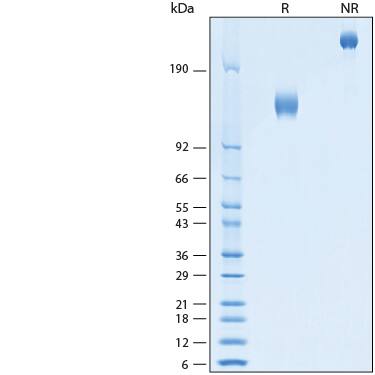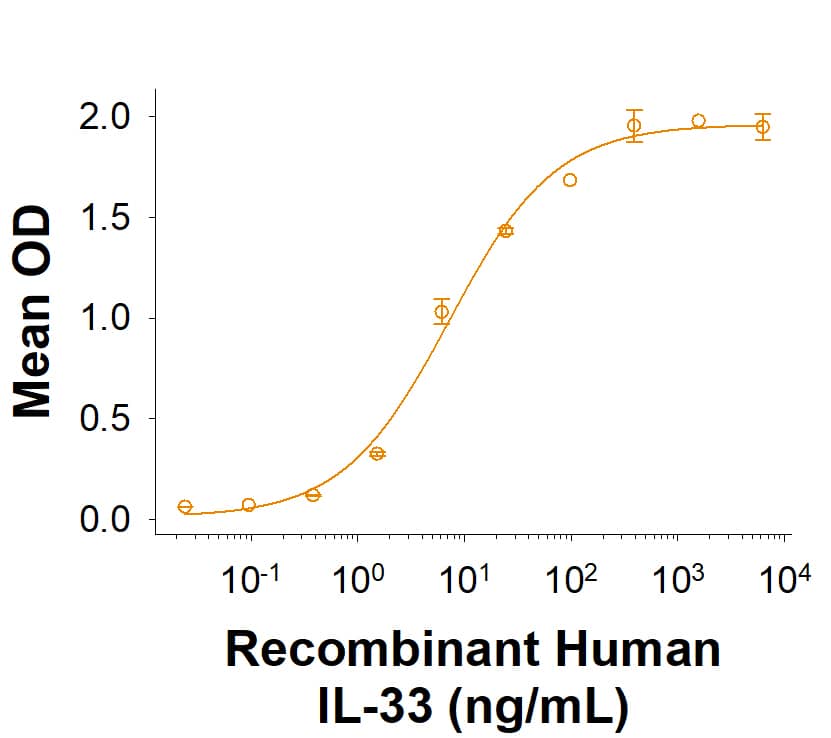Recombinant Human IL-1 RAcP/IL-1R3 ST2/IL-33R Fc Protein, CF
R&D Systems, part of Bio-Techne | Catalog # 11268-CP

Key Product Details
- R&D Systems CHO-derived Recombinant Human IL-1 RAcP/IL-1R3 ST2/IL-33R Fc Protein (11268-CP)
- Quality control testing to verify active proteins with lot specific assays by in-house scientists
- All R&D Systems proteins are covered with a 100% guarantee
Product Specifications
Source
Chinese Hamster Ovary cell line, CHO-derived human IL-1 RAcP/IL-1 R3 protein
| Human IL-1 RAcP/IL-1 R3 (Ser21-Glu359) Accession # Q9NPH3.2 |
Human ST2/IL-33R (Lys19-Ser328) Accession # Q01638.4 |
IEGRMD | Human IgG1 (Pro100-Lys330) |
| N-terminus | C-terminus | ||
Purity
>95%, by SDS-PAGE visualized with Silver Staining and quantitative densitometry by Coomassie® Blue Staining.
Endotoxin Level
<0.10 EU per 1 μg of the protein by the LAL method.
N-terminal Sequence Analysis
Ser21
Predicted Molecular Mass
102 kDa
SDS-PAGE
130-144 kDa, under reducing conditons.
Activity
Measured by its binding ability in a functional ELISA.
When Recombinant Human IL-1 RAcP/IL-1 R3 ST2/IL-33R Fc Chimera (Catalog # 11268-CP) is immobilized at 1 µg/mL (100 µL/well), Recombinant Human IL-33 (Catalog # 3625-IL) binds with an ED50 of 2.50-25.0 ng/mL.
When Recombinant Human IL-1 RAcP/IL-1 R3 ST2/IL-33R Fc Chimera (Catalog # 11268-CP) is immobilized at 1 µg/mL (100 µL/well), Recombinant Human IL-33 (Catalog # 3625-IL) binds with an ED50 of 2.50-25.0 ng/mL.
Scientific Data Images for Recombinant Human IL-1 RAcP/IL-1R3 ST2/IL-33R Fc Protein, CF
Recombinant Human IL-1 RAcP/IL-1R3 ST2/IL-33R Fc Chimera Protein Binding Activity.
When Recombinant Human IL-1 RAcP/IL-1R3 ST2/IL-33R Fc Chimera Protein (Catalog # 11268-CP) is immobilized at 1 µg/mL (100 µL/well), Recombinant Human IL‑33 (3625-IL) binds with an ED50 of 2.50-25.0 ng/mL.Recombinant Human IL-1 RAcP/IL-1 R3 ST2/IL-33R Fc Chimera Protein SDS-PAGE.
2 μg/lane of Recombinant Human IL-1 RAcP/IL-1 R3 ST2/IL-33R Fc Chimera Protein (Catalog # 11268-CP) was resolved with SDS-PAGE under reducing (R) and non-reducing (NR) conditions and visualized by Coomassie® Blue staining, showing bands at 130-144 kDa.Formulation, Preparation and Storage
11268-CP
| Formulation | Lyophilized from a 0.2 μm filtered solution in PBS with Trehalose. |
| Reconstitution | Reconstitute at 500 μg/mL in PBS. |
| Shipping | The product is shipped at ambient temperature. Upon receipt, store it immediately at the temperature recommended below. |
| Stability & Storage | Use a manual defrost freezer and avoid repeated freeze-thaw cycles.
|
Background: IL-1 RAcP/IL-1 R3
References
- Chackerian, A.A. et al. (2007) J. Immunol. 179:2551.
- Bergers, G. et al. (1994) EMBO. J. 13:1176.
- Tago, K. et al. (2001) 285:1377.
- Hiroyuki, I. et al. (2004) Biochim. Biophys. Acta. 24:1.
- Funakoshi-Tago, M. et al. (2008) Cell. Signal. 20:1679.
- Kearley, J. et al. (2009) Am. J. Respir. Crit. Care. Med. 179:772.
- Coyle, A.J. et al. (1990) J. Exp. Med. 190:895.
- Imai, Y. et al. (2013) PNANS. 110:13921.
- Hueber, A.J. et al. (2011) Eur. J. Immunol. 41:2229.
- Li, P. et al. (2015) Clin. Exp. Dermatol. 40:163.
Long Name
Interleukin 1 Receptor Accessory Protein
Alternate Names
IL-1 R3, IL-1RAcP, IL1RAcP, IL1RAP
Gene Symbol
IL1RAP
UniProt
Additional IL-1 RAcP/IL-1 R3 Products
Product Documents for Recombinant Human IL-1 RAcP/IL-1R3 ST2/IL-33R Fc Protein, CF
Product Specific Notices for Recombinant Human IL-1 RAcP/IL-1R3 ST2/IL-33R Fc Protein, CF
For research use only
